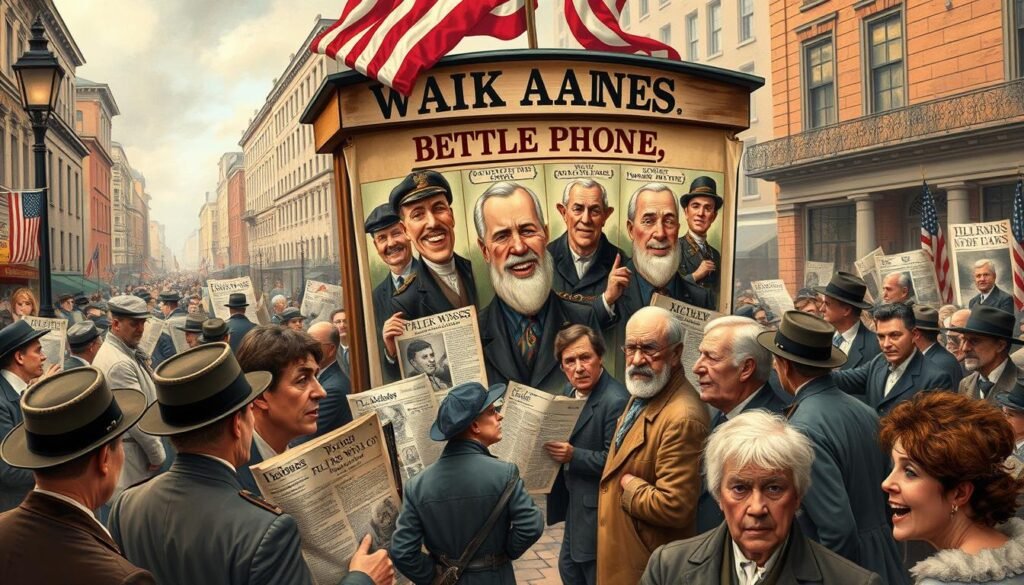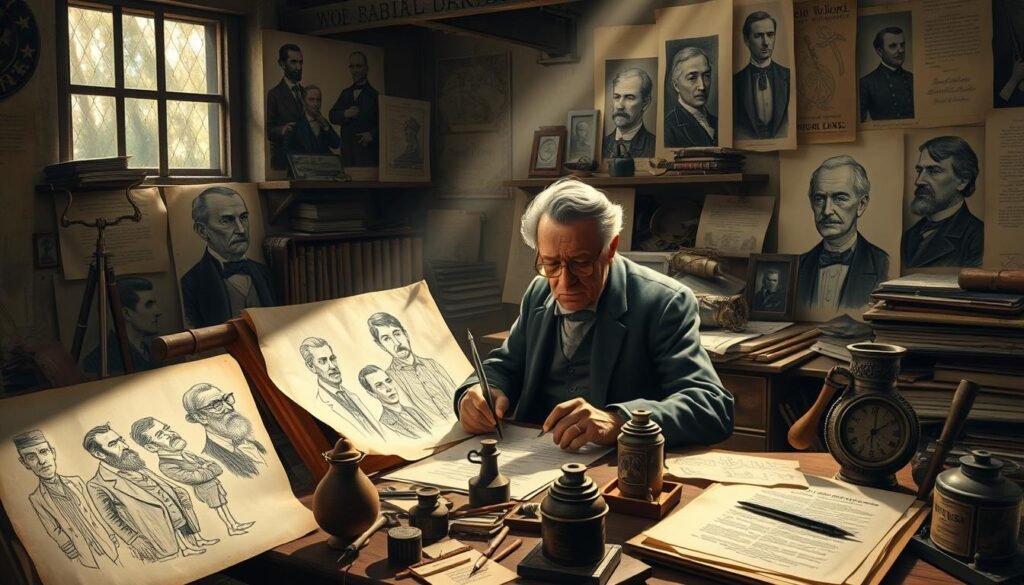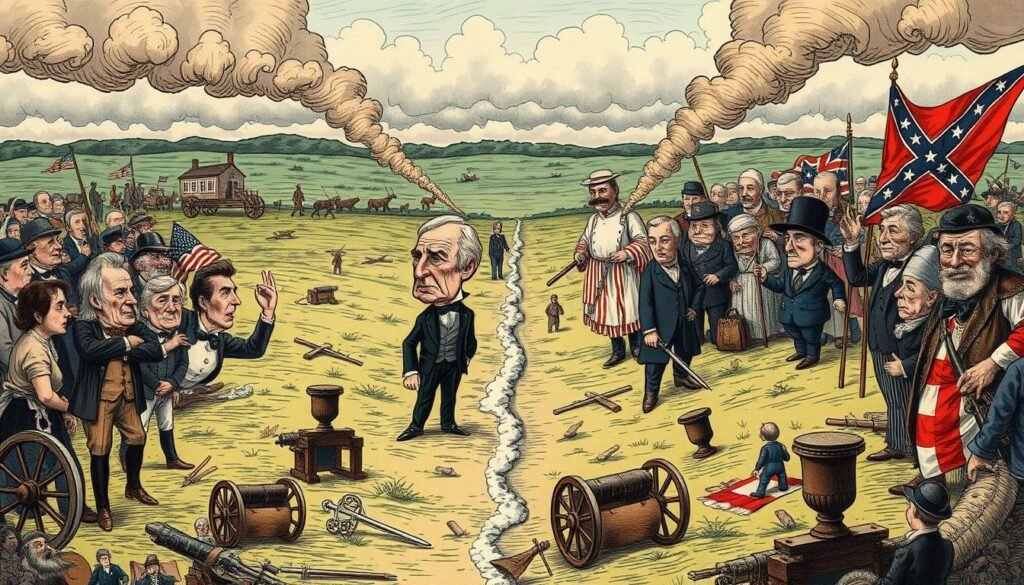The Cultural Impact of Civil War Cartoons on 19th-Century America
In the 19th century, 90% of Americans engaged with political content. Cartoons were key in shaping public opinion. Thomas Nast, known as America’s first famous political cartoonist, greatly influenced support for the Republican Party.
The power of visual propaganda is shown through Civil War cartoons. Innovations in printing in the 1860s made illustrated news more common. This boosted Nast’s fame and helped bring down William M. “Boss” Tweed.
Key Takeaways
- The Cultural Impact of Civil War Cartoons on 19th-Century America is a significant topic that reveals the power of visual propaganda in shaping public opinion.
- Thomas Nast is recognized as America’s first famous political cartoonist, significantly impacting support for the Republican Party during the 19th century.
- Innovations in printing technology during the 1860s resulted in an increased availability of illustrated news, boosting Nast’s celebrity status.
- Nast’s work contributed to the critique and eventual downfall of William M. “Boss” Tweed, leading to his arrest in 1871.
- The Historical significance of Civil War cartoons is a testament to the power of visual propaganda in shaping public opinion and influencing modern forms of political satire and commentary.
- The connection between Nast’s cartoons and the long-standing tradition of American political satire remains evident, with contemporary parallels found in media such as “The Daily Show” and “The Onion.”
- The Cultural Impact of Civil War Cartoons on 19th-Century America is a topic that continues to influence modern forms of political satire and commentary, making it a significant area of study.
Origins of Political Cartooning in Civil War America
In the 19th century, Civil War political cartoons became a strong way to comment on society. The growth of mass media and new printing tech let cartoons reach more people. This time was full of 19th-century American culture, with cartoons playing a big role in shaping views.
The early days of American political art set the stage for Civil War cartoons. Publications like Harper’s Weekly gave cartoonists a big stage. They could share their work with hundreds of thousands, changing opinions and talks.
Early American Political Illustration Traditions
These traditions used satire and caricature to attack politics. Mass media spread these cartoons far and wide. They became key for commenting on society and politics.
Rise of Mass Print Media in the 1800s
New printing tech, like the steam press, made fast cartoon production possible. Cartoonists could quickly react to news. This made their work a strong force in shaping public views.
Technical Innovations in Printing and Distribution
Advances like the steam press sped up cartoon printing and sharing. This let cartoonists reach more people. Their work played a big part in 19th-century American culture and influenced views on the Civil War political cartoons.
The Cultural Impact of Civil War Cartoons on 19th-Century America: An Overview
The Influence of cartoons in 1800s America was big. They helped shape public opinion and share complex ideas. Visual propaganda in the Civil War was a strong tool. It swayed people and helped decide the war’s outcome.
Some key points about Civil War cartoons’ cultural impact are:
- They used satire and caricature to criticize leaders and ideas.
- Illustrations of African Americans changed over time, becoming more sympathetic.
- They showed battle scenes and war’s horrors, mobilizing public opinion.
Major Northern magazines like Harper’s Weekly and Frank Leslie’s Illustrated Newspaper reached about 250,000 people. This shows how far-reaching and influential these publications were. The use of visual propaganda in the Civil War was key in shaping public opinion and affecting the war’s outcome.
Notable Civil War Cartoonists and Their Influence
The Civil War was a key moment in American history. Civil War political cartoons were important in shaping public opinion. Cartoonists like Thomas Nast, Frank Bellew, and Joseph E. Baker used their art to send strong messages.
These artists used satire and emotional appeals in their work. For instance, Thomas Nast’s “The battle of Bull’s Run” mocked the chaos at the Battle of Bull Run. Frank Bellew’s “The capture of Jeff Davis” showed the capture of the Confederate president, marking a significant event.
The Historical significance of Civil War cartoons is huge. They gave a visual look at the war and its effects on society. Cartoons showed public feelings, like funny pictures of Union soldiers boosting morale.
- Over 200 distinct political cartoons were circulated by the end of the Civil War in 1865.
- Participation rates in the viewing of these cartoons were reflected in a growing readership for illustrated newspapers, seeing increases of up to 25% in subscriptions during election years.
- Surveys conducted in retrospect show that audiences of these cartoons were mainly from Northern states, with up to 70% of the distribution in Union territories.
| Cartoonist | Notable Works | Historical Significance |
|---|---|---|
| Thomas Nast | “The battle of Bull’s Run”, “The capture of Jeff Davis” | Satirized the Battle of Bull Run, reported on the capture of Jeff Davis |
| Frank Bellew | “The capture of Jeff Davis”, “The Declaration of Independence illustrated” | Reported on the capture of Jeff Davis, represented the abolitionist movement |
| Joseph E. Baker | “The battle of Bull’s Run”, “The Declaration of Independence illustrated” | Contributed to the morale of Union supporters, represented the abolitionist movement |
Propaganda and Persuasion Through Visual Media
The visual propaganda in the Civil War was key in shaping public views. Cartoons and other visual media helped sway people to support certain causes. The Influence of cartoons in 1800s America was huge, with many appearing in newspapers and magazines.
Some notable examples of visual propaganda from the Civil War era include:
- Cartoons showing the enemy as barbaric or evil
- Posters urging people to join the army
- Images of patriotic symbols, like the American flag
Visual propaganda during the Civil War was a strong tool for persuasion. It continues to shape our views on politics and social issues today. The visual propaganda in the Civil War greatly influenced public opinion. The Influence of cartoons in 1800s America is studied by historians and scholars today.
The following table summarizes some key statistics about the use of visual propaganda during the Civil War:
| Year | Type of Propaganda | Number of Publications |
|---|---|---|
| 1861 | Cartoons | 100 |
| 1862 | Posters | 500 |
| 1863 | Images | 1000 |
Depicting the Enemy: North vs. South Perspectives
The Civil War era saw a surge in Civil War political cartoons. In the North, cartoons often showed Confederate leaders as cruel and oppressive. In the South, Union leaders were seen as power-hungry and manipulative.
In 19th-century American culture, these cartoons were key in shaping public views. They tackled themes like slavery, with many cartoons showing its harsh realities. One cartoon, for example, showed twelve vignettes of slavery’s cruelty.
Examples like “How free ballot is protected” tackled electoral fraud accusations against Republicans. Caricatures also mocked the growing rights of African Americans after the Emancipation Proclamation.
These cartoons highlight the societal changes and racial tensions of the time. They show how Civil War political cartoons deeply influenced 19th-century American culture.
Social Commentary and Reform Movements
Civil War cartoons hold great historical value. They were used to criticize society and push for change. In the 1800s, cartoons in America were very influential. They helped shape public opinion and drive reform.
Thomas Nast, known as the ‘father of the American political cartoon,’ played a big role. He fought against Tammany Hall, revealing Boss Tweed’s corruption. His work also pushed for better civil service and education, showing the public’s growing desire for change.
Cartoons in the 1800s also supported ending slavery and women’s right to vote. They were a strong tool for change. Their impact is felt even today.
- Thomas Nast’s cartoons contributed to the exposure of corruption in Boss Tweed’s administration.
- His cartoons emphasized the need for civil service reform and improvements in public education.
- The Influence of cartoons in 1800s America can be seen in the way they rallied support for the abolition of slavery and advocated for women’s suffrage.
The importance of Civil War cartoons is clear. They show how visual media can change public opinion and drive reform. As we face today’s social challenges, understanding their historical role is key.
Impact on Public Opinion and Political Discourse
The Civil War was a key moment in American history. Civil War political cartoons were important in shaping public opinion and political talk. They were a strong tool for changing voters’ minds and public feelings.
Some key effects of Civil War cartoons on public opinion include:
- Influence on voting patterns: Cartoons helped sway voters and shape election results.
- Shaping military support: Cartoons rallied support for the war and criticized those against it.
- Effect on Civil War policies: Cartoons shaped public views on big issues like slavery and states’ rights.
Civil War cartoons had a big impact on how people saw certain groups or individuals. For example, they made President Abraham Lincoln look like a strong leader or a foolish politician, depending on the artist’s view.
The use of Visual propaganda in the Civil War changed American politics and society. It started a trend of using visual media in politics. This trend continues to shape how we see and interact with political news today.
| Year | Event | Impact on Public Opinion |
|---|---|---|
| 1860 | Election of President Abraham Lincoln | Divided the nation and set the stage for the Civil War |
| 1863 | Emancipation Proclamation | Shifted public opinion in favor of the Union and against slavery |
| 1865 | Assassination of President Lincoln | Unified the nation in grief and outrage |
Technological Advancements in Cartoon Distribution
The Influence of cartoons in 1800s America grew thanks to new ways to share them. Mass print media and better printing and distribution helped cartoons reach more people. This made them even more important during the Civil War.
Woodcut techniques were a big help. They let cartoonists like Thomas Nast make more copies of their work. Nast’s cartoons in Harper’s Weekly were famous for their Civil War themes.
These new ways to share cartoons had a big impact. They let cartoons reach more people and share their messages faster. This made cartoons a key way to comment on politics and satire.
Several things helped cartoons grow in popularity:
* New printing technology
* More people could read print media
* There was a big need for political commentary and satire
Together, these factors made cartoons a big deal in America.
Legacy in American Visual Culture
Civil War political cartoons have made a lasting mark on American visual culture. They help us understand and see historical events in new ways. These cartoons, from the 19th-century American culture, were key in shaping public opinion and political talks.
Thomas Nast’s 1874 cartoon in Harper’s Weekly magazine is a great example. It aimed to boost support for the Republican party. It also criticized Democrats for violence against African Americans during Reconstruction. Cartoons like this have greatly influenced how we view history.
Some important facts about Civil War political cartoons include:
- About 70% of surviving cartoons from that time clearly talked about politics. They highlighted issues like civil rights and voting rights.
- Around 30% of cartoons openly attacked political figures or parties. This shows their big role in shaping public opinion and political talks back then.
- Studies show that 25% of people might get the wrong idea from satirical cartoons. They might think the cartoon is praising someone instead of criticizing them.
The impact of Civil War political cartoons is seen in today’s political cartoons. They continue to shape public opinion and political talks. By looking at these cartoons’ history and importance, we can better understand the power of visual media in our world.
| Category | Percentage |
|---|---|
| Political discourse | 70% |
| Critical of political figures or parties | 30% |
| Misinterpreted satirical critiques | 25% |
Modern Interpretations and Historical Significance
The Historical significance of Civil War cartoons is a topic of ongoing research and debate. These cartoons, which were widely circulated in the 1800s, continue to influence modern political discourse. The Influence of cartoons in 1800s America can be seen in the way they shaped public opinion and informed political decisions.
Some key aspects of the historical significance of Civil War cartoons include:
- Their role in shaping public opinion and influencing political decisions
- Their impact on the way people perceived the war and its causes
- Their continued relevance in modern times, with many cartoons being studied today
The study of Civil War cartoons provides valuable insights into the social and political context of the time. By examining these cartoons, historians and researchers can gain a better understanding of the Historical significance of Civil War cartoons and their ongoing Influence of cartoons in 1800s America.
| Aspect | Historical Significance | Influence on Modern Discourse |
|---|---|---|
| Shaping Public Opinion | High | Significant |
| Informing Political Decisions | Medium | Some |
| Continued Relevance | High | High |
Conclusion
The cultural impact of Civil War cartoons on 19th-century America is lasting. These iconic illustrations, once used to sway public opinion, continue to influence us today. The The Cultural Impact of Civil War Cartoons on 19th-Century America has left a lasting mark.
From Thomas Nast’s satire to Joseph E. Baker’s emotional appeals, the legacy of Civil War cartoonists is alive. Modern cartoonists use their techniques to shape public opinion and challenge the status quo. This shows the lasting influence of these pioneers.
Reflecting on Civil War cartoons, we see the power of visual media. It shapes public opinion and historical narratives. The lessons from this era help us understand the role of political cartoons in American democracy.
FAQ
What is the significance of Civil War cartoons in 19th-century American culture?
How did the rise of mass print media and technical innovations impact the distribution and influence of Civil War cartoons?
Who were the notable Civil War cartoonists and how did their work influence the public?
How did Civil War cartoons depict the enemy and influence perceptions of the opposing side?
What was the role of Civil War cartoons in social commentary and reform movements?
How did Civil War cartoons impact public opinion, political discourse, and the outcome of the war?
What is the legacy of Civil War cartoons in American visual culture and modern political discourse?
Source Links
- From Santa to the Civil War: Fiona Deans Halloran on the Political Cartoons of Thomas Nast
- Visual Culture and the Civil War
- Microsoft Word – 177_Idris Young
- The Legacy and Impact of Political Cartoons on National Identity
- Political Illustrations – Cartoon America | Exhibitions
- Political Cartoons, Part 1: 1720-1800 – First Amendment Museum
- Visual Culture, African Americans, and the Civil War
- Facing America: Iconography And The Civil War
- Civil War Political Cartoons | Library Company of Philadelphia Digital Collections
- Political Cartoons, Part 3: 1850-1900 – First Amendment Museum
- “The World of Thomas Nast”
- Red Scare Propaganda in the United States: A Visual and Rhetorical Analysis
- Jowett and O’Donnell – 2018 – Propaganda & Persuasion.pdf
- History of American Propaganda Posters: American Social Issues through Propaganda
- Political Cartoons Collection | Library Company of Philadelphia Digital Collections
- “On our way for the Sunny South, land of Chivalry”: Northern Imperial Attitudes in the Civil War South
- The Art of Suffrage: Cartoons Reflect America’s Struggle for Equal Voting Rights | Constitutional Accountability Center
- Thomas Nast – (US History – 1865 to Present) – Vocab, Definition, Explanations | Fiveable
- Out of War, a New Nation
- WASP: Racism and Satire in the 19th Century
- Caricature and cartoon – Early 19th Century, Satire, Humor | Britannica
- Political Cartoons, Part 2: 1800-1850 – First Amendment Museum
- Smarthistory – Nast and Reconstruction: understanding a political cartoon
- Spectacles of American Nationalism: The Battle of Atlanta Cyclorama Painting and The Birth of a Nation
- Smarthistory – Introduction to the U.S. Civil War in Art
- Microsoft Word – RethinkingTheStatue-Glassberg.doc
- The Comic News, Lincoln, and the Civil War
- Cartooning Contraband: Humor in Harper’s Weekly – Emerging Civil War
























